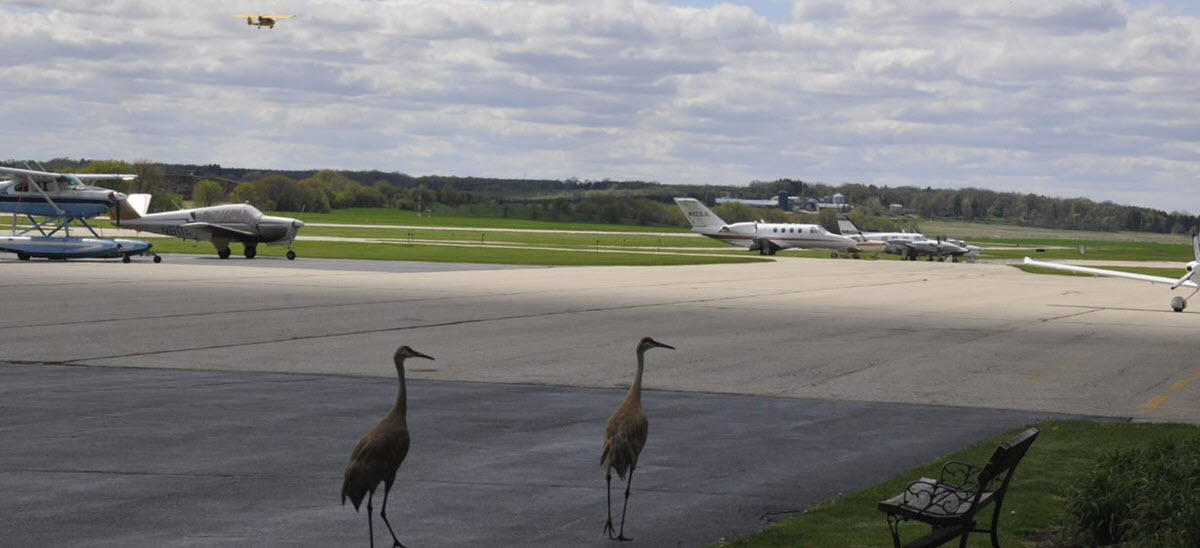By Floyd Allen
“Look, up in the air…It’s a bird…It’s a plane… Nope, it’s a bird!”
While spying a bird might not seem anywhere near as exciting as spotting Superman, for pilots, birds can be more than exciting—they can be downright dangerous!
“Birds can be a real danger,” shared Phil Sanders, owner of Triple S Repair in Kingman, Arizona. “I saw a recent photo in which a bird had gone through the windshield on the co-pilot’s side of the plane. Not only did it mess up the co-pilot, it actually destroyed some instrumentation as well.”
“Obviously, encountering birds in the air can be a disastrous situation, as both fact and fiction have taught us,” said Landon Petty, General Manager of Louisiana Aircraft in Baton Rouge.
“The ‘fact’ is perhaps best exemplified with the true story of Flight 1549, the infamous flight that ended up in the Hudson River after a flock of geese disabled their engines. The heroes of the day were pilot Capt. Chesley B. “Sully” Sullenberger III and his crew, who landed without losing a single life,” Petty explained.
“On the other hand,” he continued, “the ‘fiction’ is apparent in Indiana Jones and the Last Crusade. In the movie, when Indy and his father are pursued by a Nazi Pilot, Dr. Jones, Sr. uses his umbrella to scare up a flock of seagulls which, in turn, causes their antagonist to crash and burn.”
Fast Facts
Courtesy of Bird-B-Gone, Inc.
- The first bird strike recorded was by the Wright brothers in 1905. Wilbur Wright was flying over Huffman Prairie in Dayton, Ohio when he encountered flocks of birds on two rounds of his flight. He later recorded, “Chased flocks of birds on two rounds and killed one which fell on top of upper surface and after a time fell off when swinging a sharp curve.”
- The first fatal bird strike was in 1910 when Calbraith Perry Rodgers flew into a flock of gulls, hit them and plunged into the surf some 500 feet from the spot where he was supposed to land.
In truth, the bird-related problems that GA pilots are most likely to encounter are actually more apt to take place on the ground or at low altitudes near or on airport grounds. Most accidents occur when the bird hits the windscreen or flies into the engines while planes are landing or taking off. It’s estimated that bird strikes cause $400 million worth of damage each year within the U.S. alone and up to $1.2 billion in annual damages to commercial aircraft worldwide.
Surprisingly, one of the more costly and often overlooked “ground” problems is corrosion as the result of bird droppings. This particular by-product is so caustic that it can eat away at a plane’s finish and cost thousands of dollars in damage. In the case of military planes, it can even destroy the coating that allows a stealth bomber to be stealth.
According to Mel Johnson, Site Supervisor for Raytheon Technical Services for the Western Desert Service Area (headquartered at Sky Harbor in Phoenix), rural areas are more apt to have problems with birds than more urban areas because marshes, ponds, and grassy areas are ideal locations for geese and other waterfowl to congregate. “We’ve noticed that the advent of the Tempe Lake reservoir has greatly increased the prospect of bird hazards here in the greater Phoenix area,” he added.
While water is one of the major attractions to birds, it’s not the only one. Many airports are also doing their best to reduce the amount of agriculture activity near their location in an attempt to minimize the number of birds that come looking for food. And, sometimes, all it takes to attract birds is for them to find a place where they can nest. “We had a variety of birds, including an owl, try to nest in our old hangar,” said Sanders.
Of course, just knowing that birds can be a problem is only half the battle—and the smaller half at that! What is needed is a solution, a way to encourage them to stay away. There is likely no single, universal answer to the question: How do you get rid of birds near an airport? Each situation is unique and requires different bird control product (or maybe even several products) to be effective.
“In the case of the nesting birds we had to contend with, we found that a strobe light did the trick pretty well,” Sanders offered. Particularly effective in dimly lit buildings, the pulsing flashes of light frighten and disorient birds driving them away.
“Similarly, we’ve discovered that being in a high-profile, busy area helps,” added Petty. “The activity and noise tends to make this a less-than-attractive place for birds to be.” He went on to add that to ensure that they are, in fact, doing their part to alleviate the problem, they keep the grass in the taxiing area as short as possible.
“More extreme measures include mitigating the issue through the use of trapping or even poisoning,” Johnson shared. “While we are as concerned about nature as much as anyone, we do feel that we need to be concerned about human life first and foremost,” he explained.
There are, of course, a number of other ways to keep birds away, including, but not limited to:
- Launching pyrotechnic devices that produce loud bangs or whistling noises
- Broadcasting bird “distress” signals or recorded predator sounds
- Transmitting ultrasonic sound waves that frighten birds and other animals, but are harmless to humans
- Deploying trained birds of prey or, in some cases, dogs to patrol the area
- Eliminating/maintaining nearby vegetation, thus forcing birds to look elsewhere for food and nesting areas
- Using highly concentrated laser lights to frighten away birds at night
Obviously, where you are in the country will determine how concerned you have to be about birds, but when you are there can matter, too! For example, from late November to early December you need to be extremely aware of ducks if you’re anywhere near Stuttgart, Arkansas, aka “the Duck Capital of the World.” Arkansas is at the bottom “funnel” of North America’s bird migratory pattern, meaning that, at that time, there are more ducks around than you can shake a stick at!
“That’s why it’s absolutely imperative that if you observe bird activity you relay that information to the tower so they can pass the information on to others,” interjected Johnson.
Though lovely and fun to watch, birds can be a real problem for pilots and their planes. So while it is necessary to share the sky with them, you will want to make share that you do not share the same airspace!
What’s sauce for the goose is sauce for the Gander!
Repellents offer Eco-friendly Remedy for Gaggling Geese
Bird-B-Gone, Inc., the world’s largest manufacturer of professional bird control products, offers a liquid goose repellent called Migrate. Canada Geese eat a variety of grasses; and with each goose being able to eat up to four pounds of grass per day, this creates about three pounds (per goose) of fecal matter daily. Not only are they a hazard to airplanes, but the mess they leave behind can also be a hazard to humans on the ground.
The liquid goose repellent makes the grassy areas and surrounding shrubs inedible to geese. The goose repellent is non-toxic and safe to use around people and pets. The active ingredient in the liquid repellent is a non-toxic grape extract – Methyl Anthranilate. The extract irritates birds’ trigeminal nerves and mucous membranes. Geese do not like the sensation caused by the extract and will avoid the area being treated.
For more information on Migrate and other Bird-B-Gone products, including other bird netting and bird spikes, call 1-800-392-691 or visit www.birdbgone.com.
Skeet-R-Gone, Inc. of West Fargo, ND, distributes a bird pest control product called Flock Buster. Flock Buster is a 100% ecologically-friendly bird repellent that can be used anywhere birds are undesirable.
Originally designed as a tool for bird management in agricultural fields, Flock Buster has helped numerous farmers reclaim their land from birds who inflict costly damage to crops. The company has since expanded Flock Buster’s use to the aviation industry. Typically applied via airplane, Flock Buster can be used in and around airports to relocate birds from airport property and approach paths, reducing the risk of bird strikes.
For more information, call 877-662-7697 or visit www.flockbuster.com
About the Author
Floyd Allen is an educator and freelance writer in Phoenix, AZ, where he is a professor of history at American Indian College. In addition to writing magazine articles, Floyd is a professional blogger and novelist.






